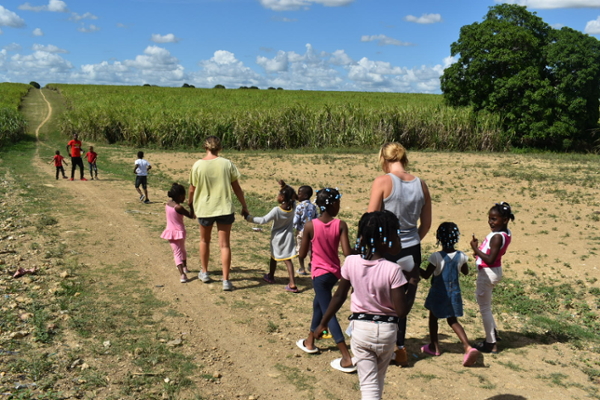
Five senior interior design students and two faculty members traveled to the Dominican Republic August 23-28 to do a site visit for the senior design project. They were primarily in the Bateyes of Central Romana, but also visited Punta Cana and spent time in Santo Domingo. A highlight was a day trip to Alta Gracia to see a project that previous Samford interior design students had designed and built.
The students will be proposing designs for a community center in the Sugarcane Community. The focus of the trip was to spend time in the Bateyes which are the settlements for workers in the sugarcane industry. These company towns provide housing for the workers and their families, but almost all are without electricity and water. The workers include both Dominicans as well as Haitian migrant workers and refugees with little to no rights.
The senior studio is focused on developing a real project for a real community. Students started to prepare for this trip last spring when they took a prerequisite course to research the Dominican culture, sugar cane economy, and other related topics. This background knowledge helped them be prepared and ready to communicate with the community.
Samford’s local partner in the Dominican Republic is the New Covenant Baptist Church pastored by Hector Santana who connected Samford with the Bateyes community.
“We ran three community-based design workshops in the Bateyes. It was an eye-opening experience for faculty and students to engage in these activities with such a lively community. We worked with children and mothers to develop an understanding of their current conditions and sought input about what their needs are. This input is helping shape the design process that the students are undertaking this semester,” said Aaron Brakke, assistant professor of Architecture & Interior Design.
“This project is our first opportunity to design and build a project for a real client with a tangible need,” said Neely Turner, one of the seniors on the trip. “Designers are naturally inclined to think in terms of what is physical rather than intangible. Going to the DR, we were not only able to physically see the land and typology, but also physically meet the people we will be designing for. Understanding how their community functions, what they value most, and how they respond to their difficult situations gave us a priceless perspective going back into the studio.”
The Interior Design students are currently developing individual proposals that will be presented to local practitioners and the community in the DR. The feedback received will help shape the work that will be developed in groups throughout the rest of the semester. These designs will be presented to the client in December who will use these designs to seek funding and will oversee the process of acquiring building permits and working with a constructor. “The Department of Architecture & Interior Design challenges our students to grow and develop throughout their time at Samford. This project embodies the mission of the School of the Arts in that it is clearly an enriching experience that ‘prepares our students to shape tomorrow’s world by inspiring artistry, promoting scholarship and realizing professionalism as we serve the community in the spirit of Christ,'”said Brakke.
Kat Budd, another senior interior design student on the trip, shared how this experience impacted her view of design. “I have always heard that interior design and architecture should not be considered a luxury service but a necessary one. This trip has proven this to me. Everyone, no matter their socioeconomic status, should be able to experience the union of spatial, aesthetic, and function that design delivers.”
Turner spent this past summer as an intern with 100 Fold Studio in Montana that focuses on international design and mission work through design. “For me specifically, after being a part of the Summer Studio program this summer and learning more about designing internationally, this was an opportunity to immediately put this knowledge into practice. There are challenges particular to this project and different aspects we must consider as we design, such as the language barrier, the metric system, and the available building materials. Most importantly, I feel as if Samford has given us an opportunity to partner with the Kingdom of Christ as we seek to meet a need through our gifts and abilities for our brothers and sisters in the Dominican Republic. I could never express enough gratitude for this opportunity and the lengths our professors have gone to make this possible for everyone involved,” said Turner.
